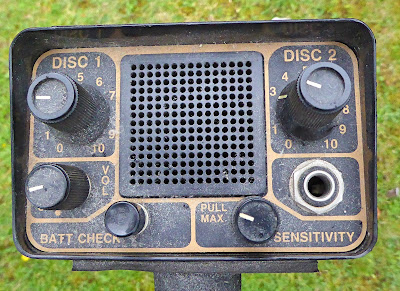I'd like to start by pointing out that this isn't a review of the Fisher 1265x it's me briefly sharing my experience with the machine. We're going back 30 years here so I'll try to articulate my thoughts the best that I can. I was out hunting literally hours after getting it, I had an old woodland not far from my house that I'd been given permission to search. The 1265x, being my first proper metal detector, felt expensive in the hands, it was sturdy, light and well balanced. The handle was really comfortable, being a concentric shape it felt far better than the round handles you get on Fishers new 'F Series' detectors. The 1265x is a one tone machine, there's no screen displaying VDI numbers, you have to tune your ear to the subtle differences within the tone depending on what type of metal you'd detected. I literally put thousands of hours of use into the detector so I started to understand what to listen for. Even if a detector only has one tone, something rather rare these days, you can still learn a lot from what the machine is telling you. I came to understand at a very early age that understanding your detector inside and out is the key to being successful.
Tone Only - No VDI Display

All detectors have their own unique language and learning to understand this language is simply time spent in the field. I quickly sussed out that coins had very short and sharp signals, whilst aluminium had this smooth tone with a lot more treble, it almost sounded like the pitch was bending, other objects had their own 'tell-tale' bleeps and crackles. Nowadays I think far too many people get fixated with the VDI numbers, I use them as a rough reference but I still go more on the tones of a target than anything else. The discrimination on the 1265x is setup via two 'Disc' knobs numbered 0 - 10. The basic approach was simple, if you went over a target and got a solid signal, you'd push the finger trigger forward, this would switch over to the 'Disc 2' setting, if you got a tone the same as 'Disc 1' then you dug the target. However if you pushed the trigger forward and got a broken tone, that was the machine telling you that the target was mostly lightly trash. The key to optimum operation was to suss out exactly where the two Disc knobs had to be, I remember I did thorough testing to get this just right.
Pinpoint Trigger - Still A Feature On The F75

One feature I thought was outstanding was the pinpoint trigger, it was very intuitive to use and I personally think that this design is still far better than most of the pinpointing features on modern metal detectors. It's no surprise to me that Fisher have kept this feature on their flagship F75 machine. In regards to depth, back in those times I'd never heard of air tests, something till this day that I find pretty pointless. I had no idea just how the deep the 1265x could go, it was all pretty simple really, you purchased a detector, put it together and got out in the fields and enjoyed yourself. Now, due to the internet, there's far too many opinions and self proclaimed experts, I get the idea that some guys spend more time testing and comparing machines than actually just getting out there and enjoying the hobby. In regards to depth, I simply turned the machine on in the knowledge that when I walked over a target I'd be alerted to its presence. Depth is another feature people seem to be totally obsessed with now, give me superb target separation over depth any day of the week.
The Classic Fisher Logo
Another handy feature that I'd use when the environment wasn't to trashy was the sensitivity knob, I found that if you had a deeper target that was giving off a whisper, cranking the sensitivity up boosted the target signal and gave you a better idea of what 'said target' could be. However this feature wasn't so great when I was dealing with really trashy environments. In regards to target separation, the 1265x does a great job of separating trash from treasure, I recall many a hunt where I managed to dig a few good coins in iron infested ground. One thing to point out, it does get tricked on large iron items, there's just no avoiding it. In regards to beach use, personally I did use it on the beach, it was a little chattery but this didn't hinder you clearly detecting good targets
A Coin Monster

In regards to finds, the Fisher 1265x is a coin eater, it loves them and I have found literally hundreds of coins with this machine, along side buttons, buckles, lead tokens, all the items you'd expect to come across. Small items are picked up well and larger items are detected comfortably at a good depth. Summing up, this machine allowed me to get started on my detecting journey, to me that's far more valuable than anything I'm ever going to find in the ground. In regards to the 1265x, it's a very capable detector that could easily hold its own compared to some of the modern detectors out on the market today - I have no doubt about that. More importantly I learnt a lot about 'Tones' and the small, minor variations that you need to listen for and I have carried this knowledge with me up to this very day. I made many great memories with the Fisher 1265x and it will hang proudly on my wall for many years to come ...... who knows I might even switch her back on one of these days and go for a quick hunt.
The Classic Fisher 1265x





Comments
Post a Comment